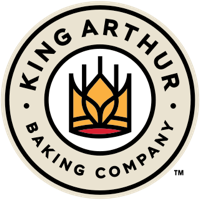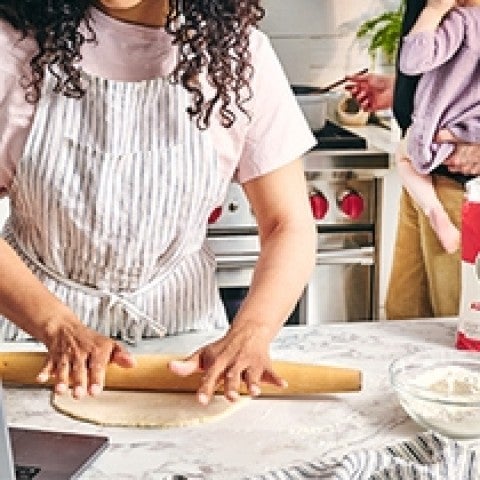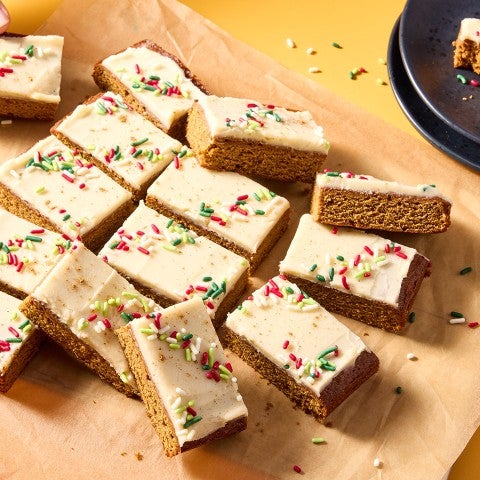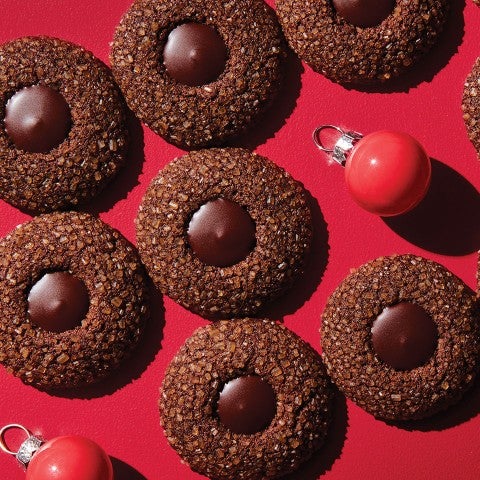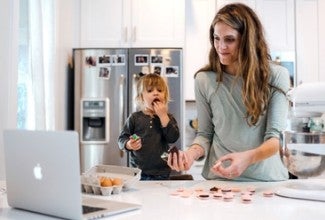It's time to talk sourdough, featuring Amber Eisler
It’s finally time. Today, we’re discussing a topic that produces a lot of confusion, passion, and toast: sourdough.
King Arthur’s very own Director of Baking Education Amber Eisler is here to share her considerable expertise. Amber baked in our bakery for five years and has taught at the Baking School for over 15 years, so needless to say, she knows her stuff. First, she and David chat about some of the biggest unexpected pain points bakers run into while making sourdough and how to solve them. Then, Amber sticks around to join Jessica and David for Ask the Bakers, answering your burning sourdough questions. We also have a special treat, a dispatch from our audience sharing the names of their sourdough starters. And, as always, Jessica and David finish up with a spicy (or in this case, sour) Jess-opinion and the recipes they’re baking this week.
Recipes and other links from this episode:
More on Amber’s Sourdough for Beginners On-Demand Class and the Baking School
Visit our Sourdough Savvy shop page for our favorite tools and ingredients
Learn more about the Big Book of Bread
Amber’s Sourdough Sandwich Bread recipe
What David’s baking this week: English Digestive Biscuits recipe
Record your question for our Ask the Bakers segment here!
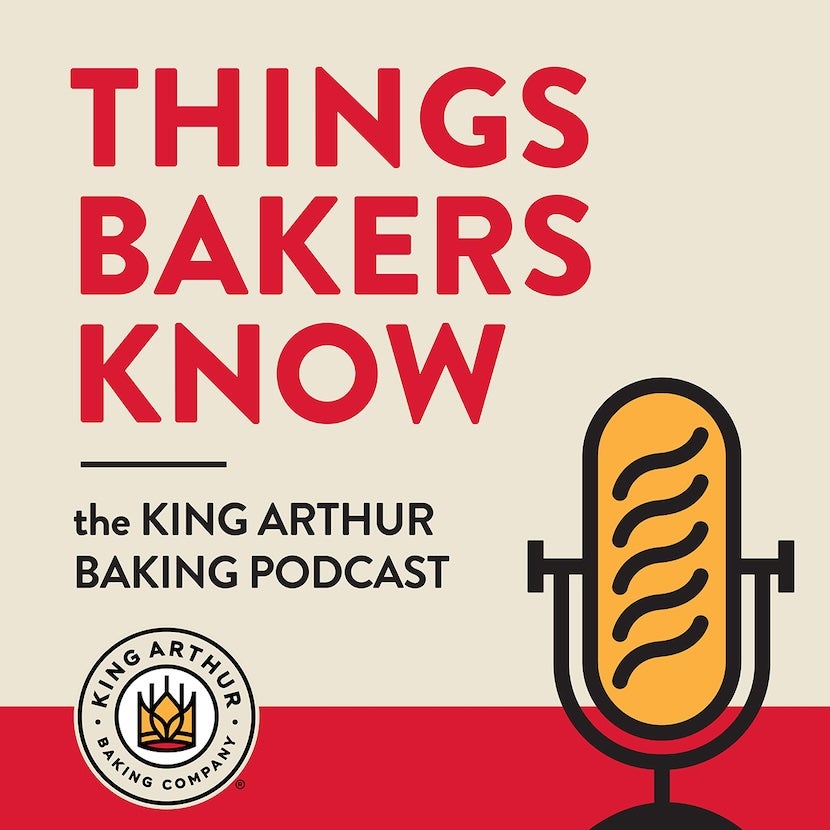
Episode Transcript
Jessica: Things that get better with age: women, cheese, wine ...
David: Nice.
Jessica: But sourdough starter?
David: From King Arthur Baking Company, this is Things Bakers Know. I'm David Tamarkin, King Arthur's Editorial Director.
Jessica: And I'm Jessica Battilana, Staff Editor at King Arthur Baking. And today we're talking about a topic that elicits a lot of passion and curiosity as well as frustration, hope, and toast. We're talking about sourdough, specifically the state of sourdough right now.
David: Before we get anywhere, I think we need to establish what our starters’ names are. Jessica, so can you please tell us what you've named your sourdough starter?
Jessica: Last October, I buckled my sourdough starter into the car and I brought it to our studio in New Hampshire because we were photographing the Big Book of Bread and we wanted to show starter at different stages. So we wanted to show one that was tragically neglected, and I volunteered to let mine be the tragically underfed. So I just ignored it for months leading up to this shoot. And then at the end of the shoot, my colleague Melanie Wanders, who was the co-author of the book, was like, nope, start over.
So she gave me some of her starter, and there's a piece of masking tape on it, and it's called Jessica's Jazzy Starter 2.0. But that's, that's it's, yeah, Jessica's Jazzy Starter.
David: What was the name of the starter that you buckled in?
Jessica: It wasn't named.
David: Oh, you just didn't name it.
Jessica: I know, I just never named it. I don't name cars. I don't name sourdough starters, my children.
David: Is the name of your dog “Dog”?
Jessica: Well, it's interesting that you say that because my childhood cat growing up was named White Cat and, and it was the daughter of another cat that we'd had whose name was? Black Cat.
David: Oh, nice.
Jessica: So what's the name of your sour starter?
David: Now that I think about it, I have no less than four starters in my fridge right now. All of varying, uh, ages. I've only named one of them, and I could have sort of, the name applies to all of them, and all of my starters are named Choices because I wanted to remind myself that when I was frustrated or when I was annoyed that I had to feed it in the middle of the night before, before going to bed, or when, or when a bread didn't come out the way I wanted it to, that this was my choice. I made it, no one to blame but me and my choices. So that's why.
Jessica: I love that and I think that is why this topic today, I mean, it's such a huge topic, right? Like we're just gonna scratch the surface because there, there are so many different, you know, aspects to sourdough baking, but I think one thing we know is that it's still very popular.
David: Extremely popular, and for good reason.
Jessica: Though it's been around for thousands of years, I feel like it really took the pandemic for sourdough to enter mainstream culture in the way that it did. I think that was a period of time when every person you knew, and maybe a lot of our listeners too, started a sourdough culture at home and started baking sourdough bread. It was like, you know, gold rush, but for sourdough, and I had been saying sort of derisively that I didn't have a sourdough starter during the pandemic. I never baked sourdough bread. And then recently I found a photo that I posted to Instagram that was of a melted container of sourdough starter. This was like April of 2020. And in fact, I did have a sourdough starter, and I put it in my oven to keep it warm or coddle it. And I turned my oven on, and I melted the plastic quart container that it was in. But I had blocked out the memory of ever having a sourdough starter during the pandemic, ever baking bread with it.
David: So wait, you thought you were immune to the trend, but you just now remembered that not only were you not immune to it, you got into it and you were traumatized. I blocked it out.
Jessica: It was buried trauma. Uh, but others fared a lot better than I did. And you see it now because people are still baking tons of sourdough bread at home.
David: Yeah, it, it was not a blip. It's kept on going. Last spring, in fact, we found ourselves in what we were calling internally here at King Arthur the second sourdough boom, because we looked at Google Trends, and our own site traffic, that the interest in sourdough was at the same level as pandemic. So it really seems like year after year, sourdough is only growing and it's becoming more and more mainstream when it used to be something niche.
Jessica: Do you feel like we've sort of reached like peak sourdough at this point, or are there still places to go?
David: I think there's a lot more ahead of us, but I think when people start their sourdough journey, they, they really have one bread in mind. They have a crusty boule or batard, uh, that has a nice open crumb, it’s probably a higher hydration bread. I think for a long time, when we think of sourdough bread, we have that loaf in mind. It's really something that I think Tartine Bread, which you worked on one of those books, right? I think you co-wrote one of the Tartine bread books.
Jessica: Yeah. The third ,Tartine book three. Yep.
David: I mean, just the fact that there were three Tartine bread books. I mean, speaks to the power of that bread in particular, and the, and the desire for people to make it and, and that's why I say sourdough has so much more to go, because there's so much more to sourdough than just that loaf.
And that's a great loaf. But you know, the other day my husband made a sourdough sandwich bread, I think from the Big Book of Bread. It's so delicious. I mean, it almost tastes like brioche. I mean, it's so tender. It's the exact opposite of that crusty loaf. It's like soft, it's, the crumb is even, you know, you can actually put something on it without it falling through. You know, and it's delicious. And I think more and more people are gonna understand that sourdough has tons of uses and can make all sorts of breads and it can have tons of uses outside of bread. Our Test Kitchen just put out a great sourdough brownie and the sourdough has a function there. It makes it super fudgy. Our friend Lukas Volger wrote a Substack newsletter about our sourdough granola recipe where we use sourdough uh, culture to create a super crispy granola that needs less sugar because the sourdough is a thing that's, you know, making it crisp and binding it all together. So there's so many places that sourdough can go, and I think we're just getting started.
Jessica: Yeah. I mean, I think everyone knows about sourdough breads or sourdough rolls and English muffins and, and bagels, but they're all these applications for sourdough discard. You know, so once you've fed your starter and you have all this discard, people are kind of realizing like, I don't wanna just like discard my discard. I want to use this flavorful matrix, you know, to work for me. And so it's getting added to all sorts of interesting things, you know? And here in South Portland, Maine, there's a bakery called Night Moves that I love.
David: Obsessed with Night Moves.
Jessica: And the baker, Kerry Hanney, is adding sourdough discard to her cacao brownie. And it's like, it's mind blowing. It has such a depth of flavor, and it plays so nicely off the chocolate. And, um, it just kind of shows you the opportunity that people have, you know, with sourdough discard as an ingredient unto itself.
David: Yeah. It's a powerful ingredient, and I think one of the things I love about sourdough is that it is function and flavor and you can choose to take advantage of both those things or just one of them. You know, obviously it has leavening power, obviously it has flavor, but you know, if you use a young sourdough starter for some of these, quote unquote discard recipes, if you're not gonna get any of that flavor at all, and that's maybe what you want, but it has the function, as you said, it's another way to get hydration and flour into your recipe.
I bring that up because I'm actually beginning to dislike the term discard recipe. Because I think we should be thinking about sourdough as an ingredient that goes beyond bread and, and it sort of sounds dismissive. Like you would only make these brownies if you're using sourdough discard when in fact, you could be building sourdough starters specifically to make those brownies because you like the flavor of those brownies. Or because you like what it does in the lemon loaf that we just put on our site recently. So I think expanding our idea of what sourdough culture is even for, is an exciting new terrain for sourdough. Although I know today we're pretty much sticking to sourdough bread.
Jessica: We're pretty, well, and that's what I was saying. I mean, there's so much to talk about that I think we had to tease out one thing that we could focus on. 'Cause we could talk for, I mean we did, when we were working on the Big Book of Bread, we talked for years, actual years ...
David: Literal years of our lives.
Jessica: Actual years of our life were spent thinking and talking about both how to start, maintain, troubleshoot with sourdough culture, but then the beautiful things that you could bake with it. So we had to just like bite off a small piece of the apple here.
David: Today we're sticking to sourdough bread because that's how most people get into sourdough. And when we called for questions about sourdough, 90% of the questions were about bread. So we're gonna bring in one of our amazing colleagues, Amber Eisler. Amber Eisler, King Arthur's Director of Baking Education, was also a bread baker at our bakery for five years, and she's been teaching at our baking school for over 15 years. In other words, she knows a lot about making great bread, particularly sourdough bread.
Amber, thanks for coming on the podcast.
Amber: Hey David, it's great to be here.
David: My first question for you, Amber, is what have you seen in your sourdough baking school classes these days? Has there been any shift in students' interest or knowledge of sourdough in the last few years?
Amber: Yeah, definitely. So when I first started teaching sourdough, most of the people were either retired engineers or health food enthusiasts. But sourdough is definitely having a moment, and we are seeing people from every walk of life baking sourdough. And there are people that see these images on social media, bubbly dough and beautiful crust, and they're like, yes, I want that.
David: I know exactly the loaf you're talking about. We're talking about a crusty loaf with an open structure. Like how hard is that to get for a beginner sourdough baker?
Amber: Oh, that's hard to say, David. Humans have been baking sourdough for thousands of years. If it was that hard, we would've given up a long time ago. But getting that perfect balance of crust and crumb and the texture, that you can spend a lifetime perfecting your loaf.
David: Totally. I feel like I've been doing that the past five years. Let's move on to fermentation and proofing. This was a real pain point for me when I started baking bread. Sometimes, honestly, it still is. Nailing the proof on a final loaf of bread before you slide it into the oven has such an enormous impact on that bread's bake, and I kept on pulling flat loaves out of the oven. And Amber, I don't think I have to tell you that I was not trying to make flatbread here. I was trying to make big, beautiful bulbous, you know, loaves of bread. Um, but I wasn't nailing the proof. I was either under proofing or over proofing. What are your tips for bakers for nailing fermentation and proofing?
Amber: Yeah, so you really have to pay attention to temperature, and this could go either way. Sometimes the dough is too cold, sometimes it's too warm. So I just think about how I react to temperature. When I'm cold, I just wanna curl up into a ball and hibernate. I don't wanna do anything. I don't rise to the occasion. But you know, when I'm at a nice, comfortable temperature, I'm at my best and the sourdough is the same. So check in. What is your room temperature? What is your dough temperature? How does that change over time?
And don't just kind of set your dough and forget about it. You gotta keep checking in with it, see how it's doing. Feel the dough. Really use your senses to see how the dough is reacting.
David: Another thing I wanna talk about, I just was talking about this with my husband yesterday as he was baking bread, is color. There's a lot of different opinions about color. I am now at a point where my loaf’s really dark and I love that sort of almost bitterness that you get from a very dark crust. My husband is not there yet, so when he bakes bread, we have, we have lighter loaves, and then sometimes they see some very, very pale loaves. Is there a right color for sourdough?
Amber: Oh, I feel like I'm gonna get in trouble no matter how I answer that one. There's a range of right, and I think there's room in the world for that really super dark bake that is just a real depth of flavor. It's like caramelization. There's definitely a range, but I do notice that students tend to just be afraid that their bread is going to burn, and as a result, they really under bake it.
And the consequences of really under baking your bread are that you have too much moisture that has not baked off. And so as soon as you pull that bread out of the oven, that crispy crust softens right up. So you don't have that crisp crust that you're, you're searching for. When I'm looking at a loaf of bread, I'm looking at the score mark, right where I've made a cut on the top of the bread. I really wanna see color in that score mark. I don't wanna just look at the top to make sure that I'm getting really nice color.
David: So when you talk about the score mark, are you talking about the deepest part of the score or perhaps the ear that forms around the score?
Amber: Yeah, I'm looking at the deepest part. So the ear is going to get color on it real fast. Right. But I'm looking where the score mark merges with the rest of the loaf.
David: And you wanna see that golden brown?
Amber: I wanna see some color there. It's certainly not gonna be as dark as the rest of the loaf, but if it's looking really pale then I'm gonna put it back in for a few more minutes.
David: That's a great tip. I love that. What is one tip, Amber, you would give to a beginner sourdough baker looking to level up their bread?
Amber: You just have to practice, practice the same bread over and over again. Don't keep chasing every wind that blows your way. You've gotta stick with the bread that you want to make and be really observant.
You know, how is your temperature changing? What's the weather like? How does the dough feel? What was the health of your starter? So it's really being detective almost, and you're really trying to pay attention to all of the variables. Stay focused, um, and just have fun with the process. You know, don't get stressed out because sometimes even the bakes that don't turn out exactly the way we hoped, they are still so good.
David: I love that, for everything really, not just for bread. I was thinking about practice and hours put into bread as you were talking, and I was thinking about the five years you spent in our bakery making bread every day, and I just imagine that when you're a bread baker in a professional setting, that you were constantly, doing what you just said, you're constantly doing the detective work to know like is the dough right? It's not, it's never quite predictable, right? Like, because like you said, it's about the moisture in the room, the temperature, everything. There's so many elements. Um, but you said it was engineers who, who were initially taking sourdough classes. I think of an engineer as somebody who like wants to design something that works each and every time. I don't know. My feeling is, and I just wonder if you agree with this, that bread is never going to be like that.
Amber: Yeah. Bread also is just such a temporary art, right? You, you bake it, you eat it, and then the next day you have to do the same thing over again, and it gives us great opportunity. But I just love being in production baking because it's the same enough. It's familiar enough that you get into this very comfortable muscle memory rhythm, but there are enough variables and surprises that you always have to stay mentally on. So I never had a bad or boring day as a baker. It is a great profession. I love baking.
David: And I think some of that, you don't get, you don't get the same level of that, of course, as, as a, as a home baker or as an occasional home baker. But I think the spirit of that is getting up and trying again and just temporary art is perfect for that. I love that. So thank you Amber. Okay, Amber, where can people find you if they wanted more of your wisdom on bread?
Amber: Well, people can find me at our baking school. I teach here in Vermont, but you can also find my new On Demand sourdough class. And I am just so excited to share sourdough in that platform. Yeah, it's just a great opportunity to reach people that might not be able to travel to our in-person schools.
David: I'm obsessed with that class. It's such a great class, and if anybody wants to learn more, we'll have a link in our show notes. As you know, Amber, people have so many questions about sourdough. It's not just me. And so while you've done a great job answering my questions, I wonder if you'd stick around to help us answer some listener questions.
Amber: I would love to.
Jessica: This episode is brought to you by King Arthur's sourdough shop. We have fresh sourdough starter you can order, so you can skip the week it takes to make one from scratch. And we also have the tools you need, like our popular sourdough crocks, and appliances, including the beloved Sourdough Home, which is like a cozy little refrigerator for your starter. We also have one of your favorite tools, David, the Raisenne Dough Riser.
David: Oh, I love that thing. It's like a little electric blanket for your sourdough starter. You put it on it and it's like the perfect temperature to make it rise and get all bubbly. And you can put your breads on it too, and it makes your breads rise easily. Um, I'm trying it with my wallet to see if I put my wallet on it and it makes like my 401k rise or something.
Jessica: That's a super handy tool, especially if you're a sourdough baker who lives in a colder climate. We also have our New York Times bestselling Big Book of Bread, which demystifies sourdough baking and is a treasure trove of recipes.
David: Who wrote that thing?
Jessica: For bread, bagels, and everything in between. I mean, who wrote that thing? Some geniuses.
David: Some geniuses named Jessica Battilana and some other people. It's a great book.
Jessica: You can find everything you need for sourdough baking at kingarthurbaking.com.
David: It's time for our next segment Ask the Bakers. For Ask the Bakers, we want to hear from you. If you have a baking question for us, head to kingarthurbaking.com/podcast to record a voice message, and we may end up using it on the show. That's kingarthurbaking.com/podcast.
Jessica: And of course, if you have a baking question that simply cannot wait, you can always reach out to our Baker’s Hotline via phone, email, or online chat.
Just go to kingarthurbaking.com/bakers-hotline. That's kingarthurbaking.com/bakers-hotline or call us (855) 371-2253. That's 2253 as in BAKE.
David: Let's hear our first question.
Caller: Hi, King Arthur. I'd really like to know a little bit more about oven spring. Sometimes my bread does a nice little puff, and sometimes it's just flat. I'd really like to know how to make it better. Thanks.
Amber: All right, so there are a lot of things that can be happening here. One of them is just the proof of the bread. So sometimes it could mean under proofed, but oftentimes when you're getting a really flat loaf, it means that your loaf has been over proofed. It's gone a little bit too long. The other thing, it could just be that you're scoring too deep, so some people maybe are a little aggressive when you're handling a lame or another tool to score the dough and you end up cutting a little deeper than necessary and that just encourages a flatter loaf.
Jessica: I feel like I'm opening up a can of worms here, but how do you know if your bread is under proofed or over proofed?
Amber: Yeah, so an under proofed loaf, it's gonna still feel really kind of tight and springy. As the dough rises, it's going to be puffier and softer, a little bit more airy. But we don't wanna get to the point where it starts to feel very fragile because that means that it's like reached the maximum volume, but then you maybe tip it out of the banneton or you slide it onto your baking stone and it just collapses. So you wanna hit that sweet spot in between.
David: This really resonates for me 'cause I feel like when I get too fragile, too sensitive, I just collapse.
Amber: Happens to the best of us.
Jessica: I think also sometimes people don't shape properly. Like they're not shaping their loaf tightly enough. So rather than like have some strength there and some shaping that will help it rise, it sort of just flops outward rather than rising upward.
Amber: Yeah, there's so many variables that that makes the baking process really fun and exciting, but sometimes it can be hard to pinpoint the exact issue.
Jessica: Let's go to our next question. You ready Amber?
Amber: I'm ready.
Caller: So mine and my daughter's sourdough starter is called Fernando, and we're kind of lazy sourdough people. So our question is, how long can we wait to feed Fernando before he gets super angry?
Amber: I see this question up come up a lot, and the question is not what you can do, but what you should do, right? So you can make bread with a starter that hasn't been fed regularly, but what kind of results are you looking for, right? And if you're looking for really, uh, beautiful fermentation, volume, flavor, you are going to want to be more attentive to those feeds and the way you think about it is, full disclosure, I am not a runner, but if I were to run a marathon, I would not do that right after I add been fasting for a week, I would carbo load. I would get all of the nutrition into my body first. It's the same with the sourdough starter. We need to feed it and care for it because it has a lot of work to do.
David: Mm-hmm. That's a great analogy. And, and I, and that is, I think where people like me get a little tripped up is because, to your point, yes, I, you can make a loaf of bread, a successful loaf of bread with a starter that's been maintained moderately well. But the difference between a loaf of bread that's been made with sourdough, that's been maintained very well is palpable. It's noticeable. So don't be like me, people. Feed your sourdough, feed Fernando, on a regular basis. To step back, what does a regular basis look like, Amber? If they're keeping Fernando in the fridge, how often should they be feeding it to keep it at peak?
Amber: Yeah, you gotta take Fernando out of the fridge at least once a week just to keep him on life support, but recognize that's all it is. That's life support, right? You want Fernando to do some heavy lifting? You gotta give him a couple of more feeds before you're gonna make some bread.
David: Take him out of the fridge, feed Fernando once, and then 12 or so hours later, feed him again. And then maybe even one more time before you start baking. Anyway, I think we can move on. I think, I think we've kept Fernando alive, we've taken him off of life support. Who's next? I think we have one more question.
Jessica: Let's get to it.
Caller: My question is, does sourdough starter get better with age? Uh, people are always talking about how old their starter is and how long they've kept it alive, and I'm wondering if this actually makes a difference and if it's actually any better for your bread. Thank you.
Jessica: Hmm. Things that get better with age, women, cheese, wine. But sourdough starter?
Amber: It's a good question. It really is. I tell students that it is much more important how you have treated your sourdough starter in the past two weeks, not the past two centuries. You know, having said that, I, I acknowledge like there's something special and powerful about having history to your sourdough.
Jessica: Yeah, it's romantic, right?
Amber: It really is. You know, everybody likes the story to tell and the connection to the past and sourdough bread baking really does give us a connection to the past, but when it comes to actually leavening and flavoring your bread, older is not necessarily better.
Jessica: Well, and I hate to sound like a jaded jerk because I, I do like the sort of romance of, oh, this was passed on. You know, and often you hear these very sweet stories of like, this was passed on to me from my late mother. This was passed on to me from a friend from across the country. Like that connection that baking brings, I think is something that totally resonates with me. But by the time you've given your sourdough started like a week of feedings, there's probably not very much left.
Like the culture has assimilated. Right. But that's okay.
Amber: Absolutely.
Jessica: I think if you want to hang onto that history, whether or not it's like microbiologically accurate, that's great. But I also think sometimes people spend a lot of energy trying to like jolly along a very sad starter because of the romance to it, when they would be better off starting over.
David: That's cold. They just move on from romance.
Jessica: Move on. I think we've knocked out all of today's sourdough questions, but I'm sure that there are more out there. But I think, uh, I don't know, Amber, if you're up for it, maybe we'll have you back again because you were definitely a brilliant crutch for the two of us.
This has been a lot of fun, and if you want more, Amber, and let's be honest, we all do, you can take a class with her at our baking school in Norwich, Vermont, or you can tune in and watch her On Demand sourdough class and we will put a link to that in our show notes. Thanks, Amber.
Amber: Thank you.
David: Next up we have something a little bit different. We asked all of you home bakers to send in the names of your sourdough starters and y'all did not disappoint. Let's listen to some of our favorites.
Various Callers: My sourdough starter's name is Ralph.
My sourdough starter's name is Gus Gus after its mother. Her starter's name was Gus. So in homage to Gus, Gus Gus.
Rise Up,
My sourdough starter's name is Domer Simpson.
My starter's name is Bubbles.
My starter's name is Harriet. I don't know why. I don't know how. I just accept it.
The name of my sourdough starter is Yeast Mode.
So I didn't give my sourdough starter a proper name, but I just referred to it as the baby. It got confusing when I then actually had a baby and I would tell my husband, I need to feed the baby and for a tiny bit at the beginning, he wasn't sure which baby I would refer to in any given moment.
Hey, the name of my sourdough starter is Fannie Ida May. Fannie Ida May was named after all the really great, strong, productive, successful women in my family. Thanks.
My sourdough starter's name is Audrey.
My sourdough starter is Breadna Pitt. My nephew’s is Bread Pitt, so they're related.
Hi, my name is Martin Sorge and I was the winner of the Great American Baking Show. The name of my sourdough starter is Pauline. She's named after a character in a Neko Case song, and I brought her all the way to London for the filming of the Great American Baking Show, and now she's a star.
Albus Dumble-dough.
Jessica: I like, what it was it, Yeast Mode? That was pretty good.
David: Yeast Mode is good. Yeah.
Jessica: I'm impressed though. People are far more creative than I am. I did just hear another great one the other day. Um, I should have gotten them to call in. They have named theirs Bread-ley Cooper after the actor.
David: So we had, we had Bread Pitt, Bread-ley Cooper.
Jessica: Yep. There's a lot of opportunities there.
David: I like anything that's named after Neko Case, so I'm sort of falling towards that one. I'm a big Neko Case fan. Yeah. I sensed a big difference between a lot of the callers and, and myself and, and you, Jessica. There's a lot of really like earnest, sweet names and the only time I've ever named a sourdough starter, it's always been either self-deprecating in some way or sarcastic or funny or, you know.
Jessica: I know so many of these were so pure, you know?
David: Yeah. They're so sweet. Very sweet stories. Yeah. And it's opening, it's opening a whole new, uh, world for me in terms of what I could name my sourdough starter and the ones that are named after other people, or that are reminders or, I think that one caller said that it was named after all the strong women in her family. That's very sweet. Because, you know ...
Jessica: Strong productive women. Not women sitting on their butts.
David: Lazy family members did not get their names worked into this starter.
Jessica: And that was just a small fraction of the names that we received. I wish we had time to play them all because they were so great. And, uh, thanks for everyone for calling in with your starter name.
David: Every episode we'd like to check in with Jessica to see what wildly surprising and full-throated ideas are in her head, a segment we lovingly call Jess-opinions. Jessica, what is your Jess-opinion this week?
Jessica: I feel like this is just like the segment that is inviting hate mail. We should have one of those disclaimers, like they have at the end of like prescriptions where they're like —
David: These opinions may cause anger. Yeah.
Jessica: This is just an opinion. Not a fact. But you know, I lived in San Francisco for almost 18 years and it was an interesting time to live there because it was right around the time that the original location of Tartine had opened. But prior to that, people had an association with San Francisco sourdough and the association that they had with it, and I think it still persists to a certain extent, is that sourdough is should be super sour, like a crusty loaf of sourdough bread should be like mouth puckeringly sour and tangy, and I just hate that style of sourdough so much. I think it is in some ways has given sourdough a bad reputation. And people will say, well, I don't like sourdough because they have this idea that it's this super tangy, unpleasant loaf. And I think, you know, honestly, the best sourdough, I suppose, is the sourdough that you like to eat. But I feel like you know, that reputation has shut some people out or convinced people that sourdough doesn't belong, say in a swirl bread or something like that.
And I know in some cases that super sour flavor is achieved through like a very long cold fermentation period, which causes the dough to develop a lot of these acids that give you that sort of tangy flavor. But I also know that there are some bakeries, especially bigger commercial sourdough bakeries, that just spike their dough with citric acid to make it extra tangy, which I just think is a crime against good bread.
David: Okay. I don't think you're, you're probably not alone in this Jess-opinion. I think people, a lot of people like you said, have been turned off by sourdough and they want their sourdough to be less sour. Your Jess-opinion is you want sourdough bread to be, well, what's the opposite of sour? Sweet?
Jessica: I guess balanced, not sweet, but just a balance, I mean I think you can appreciate the flavor of a sourdough without it like knocking you out with that sort of tanginess.
David: Yeah, it can get aggressive and you know, as a Midwesterner I support anything that like is anti-coasts, you know.
Jessica: Yes, exactly. So that's my opinion for this week that I, I am not wild about those super sour sourdough, but to each their own, I suppose.
David: To each their own.
Jessica: We are out of time. Uh, but before we go, I have one question for you, David, which is, what are you baking this week?
David: I'm on the hunt for something. I haven't nailed down the recipe yet, but I just really want some digestive biscuits.
Jessica: Yeah. Oh yeah.
David: And the reason why is last time I was up at headquarters, I brought back a bag of our new oat flour and I'm just looking for ways to use it just to check it out. And digestive biscuits keep on coming up. So I wanna make some classic digestive biscuits. I love like wheaty, oaty cookies. And I'm definitely gonna dip half of them in chocolate.
Jessica: Oh yeah, that's a good idea. I do have a recipe in my cookbook, Repertoire. They're called oat cakes in that book, but it's my grandmother's recipe. She was honestly a terrible baker, but she grew up in Nova Scotia. She was Scottish and she made exceptional oak cakes. And she liked to serve them with, um, either like a smear of butter and a halved date on top of it. Or with like a smear of soft blue cheese and a halved date.
David: Yes. I love this thing, this cookie slash cracker that can go either savory or sweet.
Jessica: Yeah, me too. So I'm also thinking of baking something sweet this week because every once in a while I get tasked with developing a recipe, and we're working on a classic Tarte Tatin. So I'm gonna try it a bunch of different ways, but one of the things I'm gonna try it with is our fast and easy puff pastry, which has sour cream in it, and it's a shortcut way to get flaky pastry, so I'm gonna try it with that. And with a pie dough and kind of compare and contrast.
David: I would not want to develop a Tarte Tatin recipe because it would just take me forever. At the same time, I would wanna develop it just so I can have lots and lots and lots ofTarte Tatin around.
Jessica: That's how I feel to. Sadly, we are out of time for today.
David: Yes. Yes, yes. Cut me off. Please cut me off. I gotta stop talking. Yes. We are outta time.
Jessica: Thank you for tuning in and joining us here on Things Bakers Know. We'll be back next week with an episode all about biscuits.
David: Remember to like and subscribe on Apple Podcasts, Spotify, Amazon Music, or wherever you listen to podcasts.
Jessica: And leave us a review while you're there or share this episode with a friend.
David: We'll see you back here next week. In the meantime, don't forget: Follow the recipe. Things Bakers Know is hosted and executive produced by me, David Tamarkin.
Jessica: And me, Jessica Battilana.
David: Rossi Anastopoulo is our senior producer. Chad Chenail is our producer and engineer. Original music by Megan and Marcus Bagala.
Jessica: This episode featured Amber Eisler, King Arthur's Baking School Director. You can learn more about the baking school as well as Amber's On Demand sourdough for beginners class at kingarthurbaking.com/baking-school. They're also linked in the show notes.
David: Things Bakers Know is a King Arthur Baking Company podcast.
